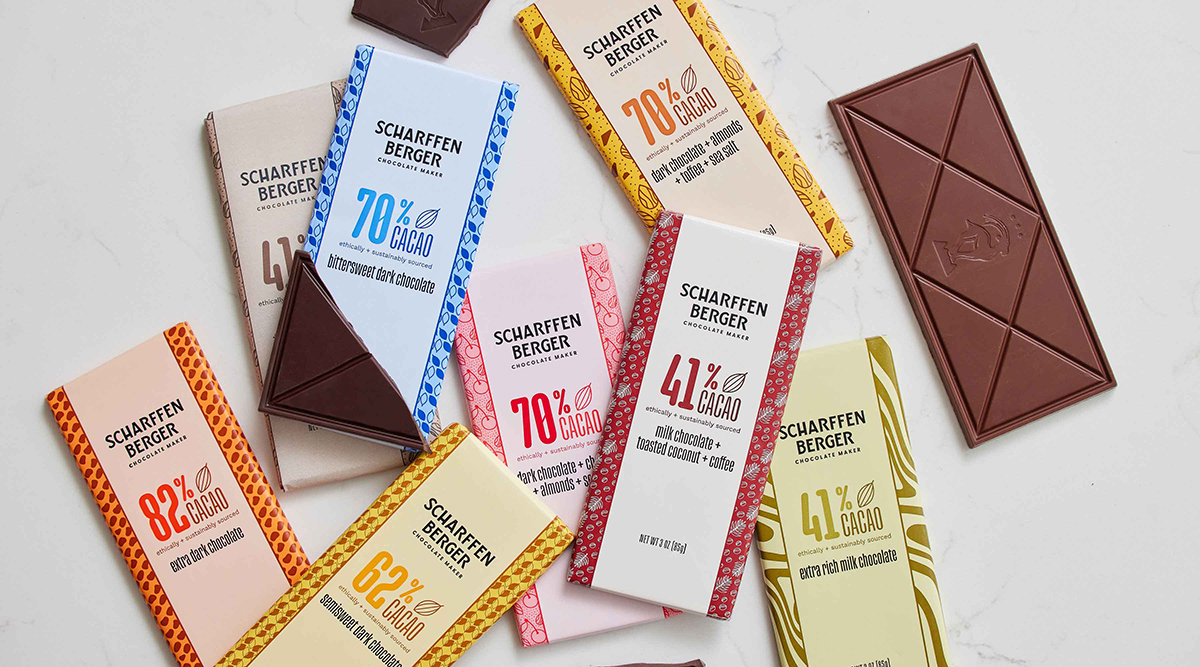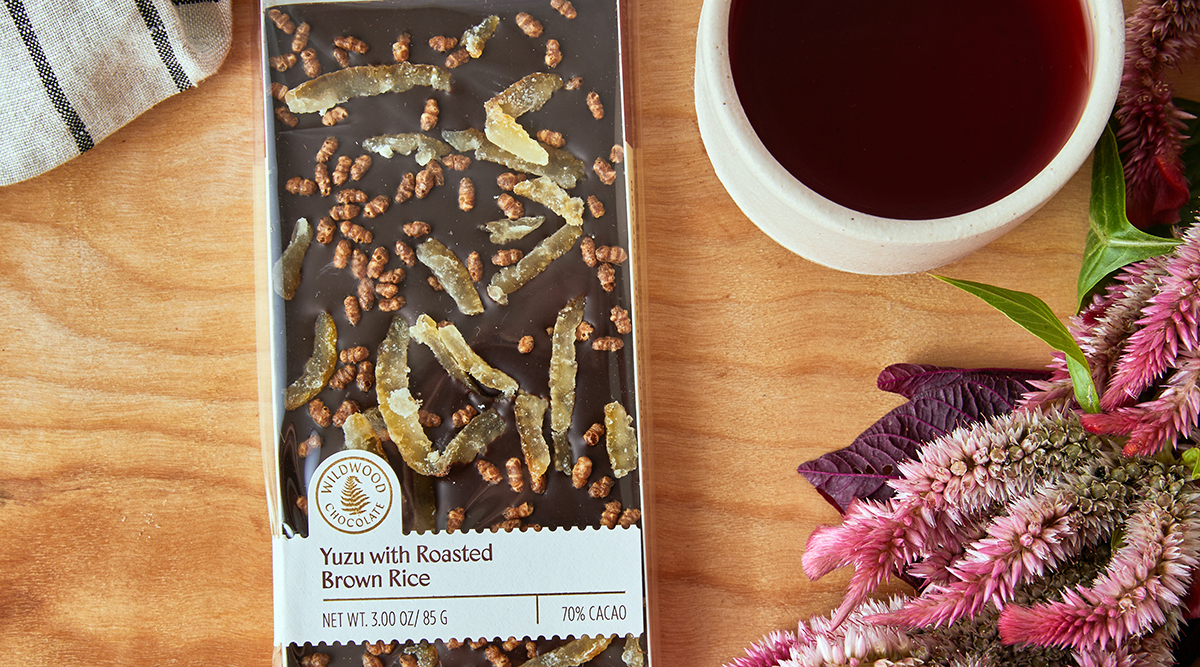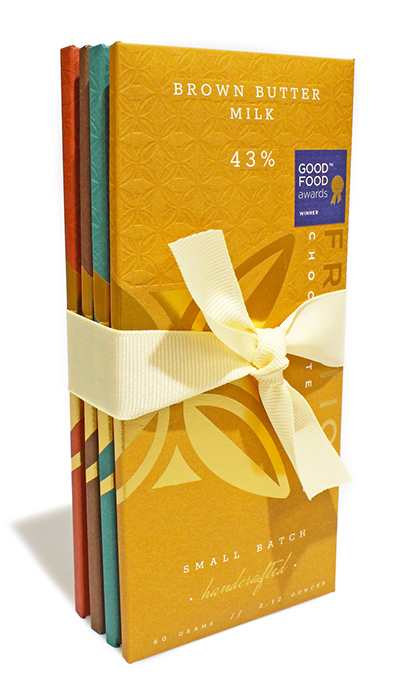A Higher Bar for Artisan Chocolate
Single-origin cacao beans, innovative inclusions, and more sophisticated connoisseurship characterize today’s craft chocolate market.

April 2023
Volume 77, No.3
Gratifying nuanced flavors. Opportunities for global adventure. Support for humane, fairly compensated farming practices. Addressing many prevailing priorities, artisan chocolate has been gaining ground among discerning consumers.
Globally, artisan and premium chocolate launches have been growing in number for the past five years, with an average compound annual growth rate (CAGR) of 4.4%, points out Innova Market Insights in a special report for Food Technology. The United States accounts for 16% of these new craft or gourmet chocolate products, dramatically surpassing all other countries in launch activity.
The consumers of craft chocolate are similar to connoisseurs of fine wine, craft beer, and premium spirits, notes industry observer Clay Gordon, founder of the online community TheChocolateLife.com. “They’ve educated themselves about chocolate and they understand why, for example, a single-origin chocolate has unique characteristics that should be savored,” he says.
But when it comes to chocolate, the best-in-class offerings are much more accessible. “Artisan chocolate is one of the most affordable luxuries in the world,” Gordon emphasizes. A common price point for a single-origin chocolate bar is $12, as opposed to thousands of dollars for a bottle of the finest wine or cognac.
In Chocolate Confectionery–U.S., a 2022 report, Mintel notes that 58% of U.S. consumers were eating more chocolate than in the previous year because they were snacking more often, while 52% were indulging more. The market research firm predicts that in 2023–2024, “evolving views regarding overall wellness” will continue to support chocolate’s market position.
Although the antioxidant properties of dark chocolate are healthful, most consumers view chocolate as a reward. Thus, flavor remains paramount across the category. “When it comes to chocolate, people aren’t willing to sacrifice taste,” Gordon says.
Bean to Bar
“Every bean has a story” is the motto of Goodnow Farms Chocolate, which makes single-origin craft chocolate bars from cacao beans grown in small geographic areas within several Latin American countries. A 2023 finalist in the Good Food Awards, the Peru Ucayali bar (70% cacao) is one SKU in the Massachusetts-based chocolate maker’s signature line of six bars.
“We get those consistent Ucayali cacao beans from farms along the Ucayali River in Peru,” says Monica Rogan, who founded the company with her husband, Tom. “Farmers from up and down the Ucayali River bring the wet cacao beans, often by boat, to a centrally located, custom-built fermentation and drying facility, where they are paid a premium for their beans.” Precise control of the fermentation and drying processes is critical to flavor development, according to Rogan. She notes that for each of its signature bars, Goodnow presses its own cocoa butter, which is made from the same single-origin cacao beans, thereby enhancing the bars’ individually distinct flavor profiles.
Orinoco Chocolate Co. is named for cacao beans harvested by indigenous people along the banks of the Orinoco River in Venezuela. But the Arizona-based firm makes single-origin dark chocolate bars from Tanzanian as well as Venezuelan cocoa. Sweetened with late-season maple sugar, each of the bars is positioned as vegan, paleo-friendly, and free of refined-sugar. Orinoco founder Christian Tyler, notes that wineries are an emerging distribution channel for artisan chocolate, which is typically sold in specialty food stores and via chocolatiers’ own retail locations and websites.
Chocolate tastings are increasingly held in conjunction with wine tastings. At such events, customers sample the flavors and terroir (the impact of topography, soil, climate, and so on) of different growing regions of cacao beans. “We take you to the Amazon basin and you can taste our Piaroa, Venezuela bar,” says Tyler. “Then you can try our Mérida Criollo bar, which is from a different region of Venezuela and has a totally different, nuttier flavor.”
Hawaii is the only state in the United States where cacao trees can grow, points out Gracie Thacker, sales director for Mānoa Chocolate Hawaii, which makes single-origin bars from Hawaiian cacao beans but also sources cacao beans from other locations around the globe. The company’s Flavors of Hawaii collection is particularly popular, she says. The recently reimagined line of bars features Polynesian-style illustrations on the packaging, and the bars range from dark chocolate to a somewhat sweeter “dark milk chocolate” to milk chocolate and have various inclusions.
Bryan Graham, who founded Fruition Chocolate Works a dozen years ago, notes that the craft chocolate category has expanded greatly in size and creativity since then. “When we started, there were about 20 companies in the United States making chocolate from bean to bar on a craft level,” he says. “Now I think there are over 200, perhaps close to 300 companies. It’s hard to keep track.”
With a background as a pastry chef and confectioner, Graham has never limited himself to the “single-origin, two-ingredient darks” that have been the segment’s mainstay, he says. The upstate New York–based firm does produce high-percentage dark chocolate bars but also has a range of sweeter dark milk chocolate and milk chocolate bars, plus a line of chocolate-coated hazelnuts, almonds, and pecans.
Scharffen Berger Chocolate Maker, which became independent of The Hershey Co. in June 2021, unveiled a major rebranding initiative late last year touting the artisanal nature of its chocolate. The company launched four new flavors in the fourth quarter of 2022: 41% cacao milk chocolate with toasted coconut and coffee; 41% cacao milk chocolate with almonds and sea salt; 70% cacao dark chocolate with almonds, toffee, and sea salt; and 70% cacao with cherries, almonds, and sea salt.
Scharffen Berger also recently announced its entry into the bite-size category with the launch of Chocolate Provisions, which feature 20 chocolate flats packaged in a cracker-like sleeve box. The new Provisions are designed for use on charcuterie and dessert boards and are available in five varieties.
Much of the innovation in craft chocolate today comes from creative inclusions and infusions. Mānoa Chocolate, which offers a subscription service to customers, experiments with novel flavor and ingredient combinations in the limited-edition bars the company releases each month.
“Hot right now in the inclusion bar category are tropical fruit pairings and spice,” observes Rebecca Adams Savage, co-president of Portland, Ore.–headquartered Wildwood Chocolate. “Our Yuzu with Roasted Brown Rice is our most recently launched and one of our most popular bars,” she says, referring to the fragrant and sour citrus fruit common in Japanese cuisine. “We found the candied yuzu at a trade show and were delighted by the unusual floral flavor,” Adams Savage explains. “We knew immediately that we wanted to make something with it but felt that it needed a companion. Paying further homage to Japan, we decided that the roasted nutty flavor of the brown rice used in genmaicha tea would be the perfect match.”
Great flavor is challenging to attain in chocolate without added sugar, but Boulder, Colo.–based Chocolove insists that it has found a winning solution in its Chocolove XO line of bars. “We wanted everyone, including those following a low-sugar diet, to be able to enjoy a no-sugar-added chocolate that delivers the same exceptional flavor experience Chocolove lovers have come to expect from us,” says Timothy Moley, the company’s founder and CEO. “Chocolove XO is sweetened naturally with inulin from chicory root and isomalt from beets. This combination eliminates the chemical aftertaste that can result from many types of sweeteners that are commonly used in other no-sugar-added confections.”
In consulting work for the chocolate industry, Orinoco Chocolate Co.’s Tyler has observed the continued emphasis on sugar reduction and sugar elimination. “Date sugar has emerged in a big way,” he says, pointing to a product made from whole dates ground into a powder.
Truffles, Bonbons, and More
Although a set of artisan chocolate bars can be a delightful, surprising gift, consumers gravitate more toward boxed craft chocolate confections for their holiday gift-giving. Chicago-based Vosges Haut-Chocolate offered several confection boxes for Valentine’s Day, including the Love Energy Ensemble, a collection of 23 colorful truffles that pair chocolate with exotic ingredients like ube, mascarpone, and black sugar caramel.
Lake Champlain Chocolates of Burlington, Vt., similarly focuses on gifts such as the company’s Organic Chocolate Frog, created with organic milk chocolate (with organic dark and white chocolate accents), and assorted collections of truffles. Also noteworthy, Lake Champlain offers a selection of Vegan Chocolate Truffles, championing the environmental sustainability benefits of reducing dairy consumption.
In both the confectionery and bar segments of the craft chocolate category, many contemporary trends are converging. Responsible sourcing and tracing food ingredients to their origin has become ever more important, notes Moley. “Traceability and transparency in the supply chain are essential to many matters, from food safety to farmer parity, and are in the realm of possibility for the artisan chocolate maker,” he says.
Provenance may be a source of pride for craft chocolatiers, but a recent Consumer Reports investigation concluded that a number of the dark chocolate bars it tested had concerning levels of cadmium, lead, or both.
“I expect the dialogue to continue regarding the presence of naturally occurring minerals and elements and what can be done with postharvest cleaning to reduce trace levels of certain elements even more,” Moley predicts. “As usual, the challenge for the artisan and small producers is to get access and influence at a level to effect change while ensuring that quality, taste, and the art of chocolate are retained.”
Digital Exclusives

10 Food Trend Predictions for 2022
The editors at Food Technology magazine, published by the Institute of Food Technologists (IFT), have announced their predictions for the hottest food trends for 2022.
Food Technology Articles

How to Formulate for Food Intolerances
In this column, the author describes the global prevalence of food intolerances and provides insight into state-of-science ingredient replacement and removal methods when formulating gluten-free and lactose-free foods.

Vickie Kloeris Shares NASA Experiences in New Book, Consumers Are Confused About Processed Foods’ Definition
Innovations, research, and insights in food science, product development, and consumer trends.

Top 10 Functional Food Trends: Reinventing Wellness
Consumer health challenges, mounting interest in food as medicine, and the blurring line between foods and supplements will spawn functional food and beverage opportunities.

Keeping Chocolate Sweet While Cutting Sugar
Penn State food scientist Gregory Ziegler experiments with substituting rice flour and/or oat flour to reduce the sugar content of chocolate.

Whipping Up a Bright New Idea
A profile of whipped cream category innovator Whipnotic.
Recent Brain Food

A New Day at the FDA
IFT weighs in on the agency’s future in the wake of the Reagan-Udall Report and FDA Commissioner Califf’s response.
Members Say IFT Offers Everything You Need to Prepare for an Uncertain Future
Learn how IFT boosts connections, efficiencies, and inspiration for its members.

More on the FDA's Food Traceability Final Rule
In a new white paper, our experts examine the FDA’s Food Traceability Final Rule implications—and its novel concepts first proposed by IFT.
Job Satisfaction in the Science of Food is High but Hindered by Pain Points
IFT’s 2022 Compensation and Career Path Report breaks it down.






